
menu

Hearing loss can occur at any age to anyone for various reasons. Hearing is one of our only senses that works continuously. Since our hearing is such a vital sense, it requires special attention. Please refer to links below to learn more.
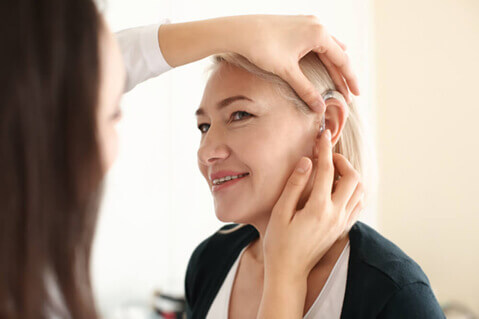
We are a medical, surgical, and audiological practice that devotes itself entirely to the diagnosis and treatment of disorders of the ear, nose and throat. The Hearing Institute is a division of The Specialty Care Institute.
Earmolds including hearing aid earmolds, swimmolds, noise plugs, iPOD molds, etc.
Tinnitus Evaluation typically includes a hearing assessment, special tinnitus questionnaires, and measures of tinnitus loudness, pitch, and its ability to be masked. Other specialized tests may be needed.
Otoacoustic Emissions testing (OAE) provides information about the hair cells in the inner ear. OAE’s are appropriate for use in patients undergoing ototoxic treatments, individuals with tinnitus, and difficult-to-test patients: newborn infants, young children, patients who are attempting to feign a hearing loss (i.e. malingering), and developmentally delayed populations.
Assistive Listening Devices that can aid in successful communication and listening (i.e. amplified telephones, TV ears, etc.)
Aural Rehabilitation Services include inservices that are offered at our clinic that focus on adjusting to hearing loss, making the best use of hearing aids, exploring assistive listening devices that might help, managing conversations, and improving communication.
Hearing loss has a lot of different causes and manifestations. It can be sudden or gradual. It can occur in one ear or both ears. It can be temporary or permanent. It happens to people of all ages and is associated with the aging process. Before discussing causes and treatments for hearing loss, it is important to understand how hearing works.
There are three sections of the ear: the outer ear, middle ear and inner ear. Each section helps move sound through the process of hearing. When a sound occurs, the outer ear feeds it through the ear canal to the eardrum. The noise causes the eardrum to vibrate. This, in turn, causes three little bones inside the middle ear (malleus, incus, stapes) to move. That movement travels into the inner ear (cochlea), where it makes tiny little hairs move in a fluid. These hairs convert the movement to auditory signals, which are then transmitted to the brain to register the sound.
Hearing loss occurs when sound is blocked in any of the three areas of the ear. The most common cause of hearing loss, and one of the most preventable, is exposure to loud noises. Infections, both of the ear or elsewhere in the body, are also a major contributor to hearing loss.
Most causes of outer ear hearing loss can be remedied. But problems of the middle and inner ear can lead to permanent hearing loss, which is why it is important to seek medical attention quickly if you are experiencing a problem hearing.
There are four types of hearing loss:
Hearing loss is measured in four degrees: mild, moderate, severe or profound. The degree of hearing loss drives the selection of the best form of treatment on a case-by-case basis.
The location, type and degree of hearing loss impact the choice of treatments for any hearing problem. The most common treatment options include:
If you experience sudden or prolonged hearing loss with dizziness, fever or pain, please contact our office right away and schedule an appointment with one of our otolaryngologists. We’ll conduct a physical examination as well as a hearing test to determine the type and severity of your hearing loss. We’ll then recommend the best treatment.

Many people experience tinnitus–a type of ringing, swooshing, or other type of noise that seems to originate in the ear or head. In most cases, tinnitus is not a serious problem and can be treated, or will often become less bothersome over time.
Tinnitus is not a disease but a symptom of an underlying condition. One of the most common conditions associated with tinnitus is high frequency hearing loss due to age and/or noise exposure. Tinnitus is also associated with conditions such as wax in the outer ear canal, middle ear fluid or infections, eustachian tube dysfunction, otosclerosis (fixation of the middle ear bone), Meniere’s disease (a problem affecting both hearing and balance), and problems beyond the inner ear such as acoustic neuroma (a small benign, rare tumor of the nerve for balance). Medications can also cause tinnitus such as aspirin, Naprosyn, Lasix, quinines, aminoglycoside antibiotics, erythromycin, renal transplant and dialysis. If head noises persist, particularly if they are on one side or are associated with loss of hearing or dizziness, medical attention is recommended.
In addition to a full ENT exam, other tests may be needed to look for any treatable causes of tinnitus. Hearing tests reveal patterns of hearing loss due to conditions often associated with tinnitus. Often times patients do not have any symptoms of hearing loss, but hearing tests reveal hearing loss in very high frequencies not normally used in everyday conversation. This is often the cause of the tinnitus. Blood tests and imaging scans may also be needed to look for rare, but treatable causes of tinnitus. MRI can reveal acoustic neuromas and other central nervous system conditions. Closed MRI machines are preferred over the open type to provide the optimal scan.
Tinnitus with an obvious cause, such as an object in the ear canal or a middle ear infection, can usually be treated easily. Unfortunately, tinnitus is usually associated with conditions for which there is no treatment. Often the noise can be especially bothersome at night when things are quiet. Maskers can be purchased which make low volume background noise to help distract you from the tinnitus at night. A radio can be used for this purpose by turning it on at night at low volume in between stations to produce background static, or a white noise machine. For tinnitus associated with significant hearing loss, hearing aids may help.
Anti-anxiety medications, anticonvulsants, and tricyclic antidepressants are groups of drugs used to treat various conditions including depression, anxiety, seizure, panic, pain, muscle spasms, dizziness, and tinnitus. Trade names include Ativan, Klonopin, Tranxene, Tegretol, Librium, Xanax, Wellbutrin, Paxil, Triavil, Elavil, Zoloft, Atarax, Sinequin, and Valium. Varying degrees of success have been reported with these drugs for tinnitus. Caution should be exercised. Some of these drugs can be habit-forming or addictive.
Medical intervention in the treatment of tinnitus has gone beyond the realm of traditional treatments. Other treatments include ultrasonic current, electrical stimulation, acupuncture, hypnosis, biofeedback, sound (tinnitus retraining) therapy, desensitization therapy (Neuromonics Tinnitus Treatment), amplification (hearing aids), cognitive therapy, and the placement of magnets near the ear. These treatments are not proven effective scientifically, but some patients report that they help. Some people are finding relief from tinnitus through the use of herbs such as Ginkgo biloba and kava kava, hormones like melatonin, and with megadoses of over the counter (OTC) vitamins and minerals such as Lipo-Flavonoid PlusTM and Arches Tinnitus Relief FormulaTM [(800) 350-9631 www.tinnitusformula.com ]. The later has been shown to reduce tinnitus (5% complete reduction, 75% partial reduction, 20% unchanged). We caution that these products may vary since they are not subject to FDA control, that there are questions about the appropriate doses, and that some of them do not differ in effectiveness from placebos. Patients should weigh the “gain versus risk factors” in determining which options to use in the treatment of tinnitus.
You may also receive more educational material by visiting the: American Tinnitus Association (ATA) [(800) 634-8978 www.ata.org ].
There are many different styles of hearing aids. The degree of the hearing loss, individual lifestyle, size and shape of ear canal, manual dexterity abilities, cost factors, and cosmetic concerns are all factors that will help to determine which style of hearing aid is best for you. Most hearing aids are Blue-Tooth compatible and can be used to stream phone conversations, music and television directly to your hearing aids.
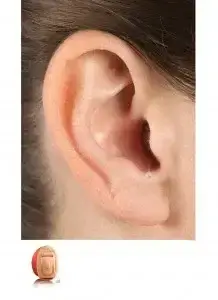
IIC: Invisible-In-The-Canal
IIC: Invisible-In-The-Canal units are the new wave of hearing aids. They are virtually invisible in the ear and are the smallest hearing aids. IICs are most appropriate for individuals with a mild hearing loss.
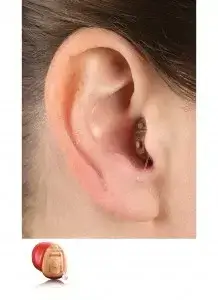
CIC: Completely-In-the-Canal
CIC: Completely-In-the-Canal units are one of the smallest hearing aids. CICs are most appropriate for individuals with a mild to moderate hearing loss.
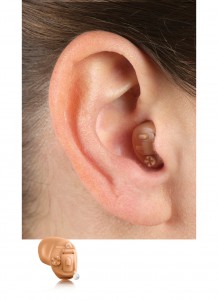
ITC: In-The-Canal
ITC: In-The-Canal units fit in the ear canal. These require good dexterity to control the volume wheels and other controls on the faceplate. They are smaller than ITEs. ITCs can only be used by people who have mild, moderate and severe hearing loss.
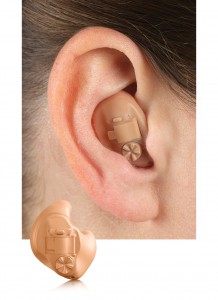
ITE: In-The-Ear
ITE: In-The-Ear units are the largest custom made style, and fits completely in the outer ear. It is easy to operate. ITEs can be used for mild, moderate and severe hearing loss.
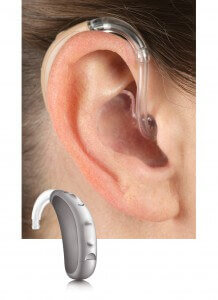
BTE: Behind-The-Ear
BTE: Behind-The-Ear hearing aids are the largest hearing aids and they are very reliable and durable. BTEs rest on the back of your ear, and are connected to the ear canal via a tube that is part of an earmold. The earmold is custom made from an ear impression. Individuals with a wide range of hearing losses can be fit with BTE hearing aids.
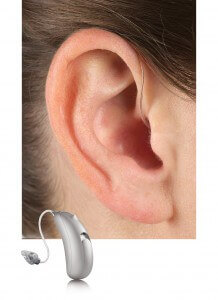
Open-Fit BTE: Open-Fit Behind-The-Ear
Open-Fit BTE: Open-Fit Behind-The-Ear hearing aids are very reliable. Open-Fit BTEs rest on the back of your ear, and are connected to the ear canal via a thin tube. The thin tube allows for a more natural sound quality. They the most patient preferred style and cosmetically appealing hearing aid.
There are three levels of hearing aid technology. These are: Analog, Digitally Programmable, and Digital.
1. ANALOG technology has been around for many decades. It is the most basic technology that offers limited adjustment capability. It works by adding the same amount of amplification to all levels of sound intensity. It is the LEAST expensive.
2. DIGITALLY PROGRAMMABLE technology is analog technology that is digitally controlled by the computer in the office to adjust the sounds of the hearing aid.
3. DIGITAL technology is the most sophisticated hearing aid technology. Digital technology gives the audiologist maximum control over sound quality and sound processing characteristics in order to provide maximum speech understanding. This is used in all types of hearing aids and is the most expensive. Digital hearing aids have been available since 1996. About 99% of all hearing aids dispensed now are digital. Within digital technology, there are three tiers: Entry level, Mid-level, and High-end.
It should be noted that all levels of digital hearing aids can connect to telephones (cellphones), IPODs, MP3 players, etc. via Bluetooth technology.
Automatic– Automatically switches from an omni-directional microphone to a fixed directional microphone depending on the individual’s environment.
Automatic/Adaptive– Automatically switches from an omni-directional microphone to a fixed directional microphone depending on the individual’s environment. In addition, it adapts to where speech is coming from for maximum speech understanding.
The costs of hearing aids range from $1500-$3500 for one device. The cost of the hearing aid is determined by the type of technology that is chosen. The type of technology that is chosen is based on the individual’s lifestyle, concerns, and goals for hearing.
Before a hearing aid is recommend to a patient, the staff of The Hearing Institute will request medical clearance from a physician, preferably an otolaryngologist or otologist, to rule out any medical condition(s) that preclude the use of amplification. This policy is done in the patient’s best interest. Medical clearance may be provided by our ENT Doctors of Specialty Care Institute, or your own physician.
Once medical clearance has been obtained, the patient will be seen for a Hearing Aid Evaluation. During this appointment, the audiologist at The Hearing Institute will discuss the patient’s hearing loss and its impact on communication. Various styles and technology levels of hearing aids will be discussed. Most patients and their families have many questions that will be addressed. Make sure to bring a companion to make sure all questions are answered. One hour is devoted for the initial hearing aid evaluation. There is no charge for this appointment.
The Hearing Institute works with several hearing aid manufacturers (Unitron, Phonak, Oticon, GN Resound, Widex, Siemens and Starkey) that offer digital hearing aids in a variety of styles and sizes. The Hearing Institute also offers assistive listening devices (i.e. telephone amplifiers/amplified telephones, TV Ears, etc.) and hearing aid accessories (devices to connect via Bluetooth to cell phones, televisions, etc.) according to patient needs and lifestyle. The cost of a hearing aid varies from approximately $1500 to $3500 for each aid, based on circuitry and features. Once the hearing aid(s) are ordered, the aid will arrive in approximately two weeks or sooner, depending on the style, for which a second appointment is scheduled. Full payment of the hearing aid is required at the fitting appointment.
At the hearing aid fitting, the audiologist will program the hearing aids and discuss several features of the aid including: how to insert and remove the aid from the ear, change the batteries, clean and maintain the aids, etc. The owner of the aids will have an adjustment period of 30 days. This adjustment period allows for any necessary fine-tuning of the aids.
Medicare does not pay for hearing aid evaluations, hearing aids, or services related to hearing aids. The Hearing Institute does not accept any insurance contracts for payment of hearing aids. If you are aware of any coverage for hearing aids by your insurance, you will be responsible for obtaining reimbursement.
Our office offers Care Credit as a payment option.
Earmolds for personal electronic devices – Used to improve the fit and comfort of the universal earbuds. These earmolds are custom made to ensure that they will never fall out of your ears. In addition, help to reduce external noise. Commonly used for IPODs, MP3 players, CD players, hand-held games, cell phone head sets, etc.
Hearing Protection for Musicians – A great option for anyone who needs to hear in noise. Helps to reduce excessive noise to a safer volume, and still allow the individual to hear conversation.
Swim plugs – Help to reduce moisture from entering the ear canal while swimming or bathing.